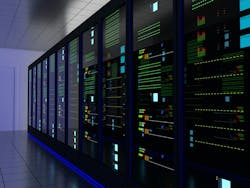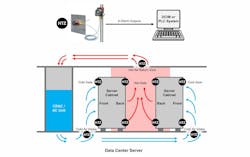Key Highlights
- Environmental monitoring is essential for preventing hardware failures caused by overheating, humidity fluctuations and electrostatic discharge.
- Integration with DCIM platforms and industry-standard communication protocols ensures comprehensive and reliable environmental management.
- Advanced sensors like Moore Industries' HTZ transmitters provide accurate, stable measurements crucial for maintaining optimal conditions and reducing operational costs.
Data centers are the nervous systems of today’s digital infrastructures, powering everything from artificial intelligence (AI) and financial transactions to cloud-based applications. These facilities house mission-critical IT equipment, including servers, storage devices and networking hardware, which must remain operational 24/7. Any interruptions or equipment failures can lead to substantial financial losses, reputational damage or even legal consequences.
While power and cybersecurity often take center stage in data center designs, environmental factors such as temperature and humidity are equally crucial. Improper climate conditions can cause hardware failures, decreased equipment life and inefficient energy use. Consequently, environmental monitoring is a foundational element of any data center’s management strategy (Figure 1).
Monitoring conditions matters
For instance, overheating is a silent threat because servers and related hardware generate significant heat during operation. If not properly cooled, internal temperatures can exceed safe operating thresholds, causing hardware to malfunction or shut down entirely. Even momentary overheating can lead to data loss or corruption.
Similarly, too much or too little humidity can each be hazardous. High humidity can produce condensation that risks short circuits and corrosion, while low humidity increases the potential for electrostatic discharges (ESD) that can also damage sensitive electronics.
Meanwhile, energy efficiency is necessary because overcooling data centers to avoid overheating can drive up energy consumption and operating costs. This is why more sustainable approaches require precise monitoring to keep conditions within optimal ranges.
Likewise, these hazards or combinations of them are the reason that service-level agreements (SLA) and industry standards depend on documented, verifiable environmental controls. To maintain safe operating environments in data centers, the American Society of Heating, Refrigerating and Air-Conditioning Engineers (ASHRAE) recommends basic environmental ranges of 18 °C to 27 °C (64 °F to 80 °F) and 40% to 60% RH. Preserving these ranges minimizes risks of equipment failures, and supports more efficient energy use.
Best sensing and systems practices
However, just as optimal humidity and temperatures ranges rely on accurate and constant monitoring, this effective monitoring in turn depends on proper sensor deployment, using appropriate monitoring systems, and coordinating with data center infrastructure management (DCIM) platforms.
Depending on the monitoring required, ideal sensor locations include:
- Rack inlets and outlets for capturing air intake/exhaust conditions,
- Cold and hot aisles that ensure effective airflow distribution,
- Underfloor air plenums for monitoring cooling delivery effectiveness,
- Ceiling ducts that can track return air trends, and
- Uninterruptible power supply (UPS) locations and battery rooms, where users can monitor humidity-driven condensation risks.
In addition, the three main types of environmental monitoring systems include: spot monitoring with fixed sensors to provide point-specific data; zone monitoring that examines environmental conditions across designated areas; and mobile monitoring with portable sensors or devices used for temporary diagnostics.
After appropriate sensors and system types are selected, environmental monitoring solutions must also integrate with existing or applicable DCIMs, which also rely on real-time sensor data to optimize their environmental controls and energy efficiency. Their sensors should likewise provide industry-standard outputs and open communication protocols compatible with most SCADA, PLC or other control systems, such as 4-20 mA, HART or Modbus.
Get your subscription to Control's tri-weekly newsletter.
Once sensors, system types and DCIM integration is in place, real-time environmental monitoring can successfully:
- Prevent downtime with early detection of temperature or humidity deviations, which allows quick corrective actions;
- Extend equipment lifespan by operating within optimal ranges, which also reduces thermal stress and corrosion;
- Improve energy efficiency by enabling fine-tuning of HVAC controls to avoid costly overcooling; and
- Support compliance by meeting industry standards and contractual SLAs.
Data center scenarios
To show how these environmental-monitoring sensors, systems and principles are implemented, consider a large-scale data center project that’s underway to support high-density computer servers operating 24/7. To ensure maximum equipment reliability and system uptime, the facility’s design includes a comprehensive environmental control strategy. As usual, maintaining the correct balance of temperature and humidity is essential for protecting servers and minimizing risks associated with overheating, electrostatic discharge or condensation.
The data center has approximately 150 measurement points. Sensor placement in these areas enables environmental visibility, and supports rapid anomaly detection (Figure 2).
They’re located in:
- Cold aisles, where users can monitor cooled intake air delivered to servers;
- Hot aisles, where measuring exhaust air can verify thermal output;
- Above and below server racks to ensure environmental uniformity in sensitive equipment zones; and
- HVAC supply and return ducts to validate performance of air handling systems.
More specifically, in high-availability data centers, precise environmental control is nonnegotiable. Server rooms must maintain relative humidity between 40% and 60% because, if humidity falls below 40%, static electricity can build up, potentially causing ESD and equipment damage. However, if humidity rises above 60%, condensation can cause corrosion, short circuits or catastrophic failures.
Given the need for continuous, 24/7 operations and the risks posed by even minor deviations, environmental monitoring must be accurate, scalable, reliable and easily deployed. One solution that meets these needs is Moore Industries’ HTZ humidity and temperature transmitter. It’s designed for industrial environments, and provides:
- Accurate and stable RH and temperature measurements,
- 4-20mA analog output with HART communications,
- Compact and rugged construction for versatile installation, and
- Low maintenance costs and long-term reliability.
Thanks to these capabilities, HTZ lets data centers maintain stable humidity levels within the recommended 40-60% range; reduce risk of ESDs and condensation-related equipment damage; minimize downtime and maintenance issues; ensure 24/7 uptime with high-resolution environmental data for continuous optimization; and support facility-wide redundancy with dense sensor coverage across all critical airflow zones.
Finally, using HTZ lets data centers ensure robust environmental monitoring across their mission-critical zones. Its performance and adaptability make it ideal for high-availability IT infrastructures, supporting long-term uptime, efficiency and lower operating costs.
Precision temperature and humidity monitoring transmitter
To accurately and repeatably measure humidity and temperature in data centers, Moore Industries provides its HTZ smart HART, compact, loop-powered humidity and temperature transmitter. Originally engineered to meet the precision and reliability demands of semiconductor fabrication rooms, HTZ’s easy programming and installation makes it ideal for data centers where uptime is critical.
HTZ’s primary features and benefits include:
- High accuracy of ±2% relative humidity (RH) and ±0.3 °C ensures reliable data for decision-making
- 4-20 mA HART output enables simple integration with PLCs, SCADA systems or building management systems (BMS)
- Long-term stability that minimize calibration schedules
- Rugged, compact housing that fits into tight spaces, and withstands industrial environments
- HART protocol support that eases configuration and maintenance
- Combined temperature and RH functions that reduce installation complexity and cost
- Industrial-grade measurement capabilities that are designed and built to last, and are superior to building-management sensors
About the Author

Bob Myles
Moore Industries-International Inc.
Bob Myles is engineering director at Moore Industries-International Inc.

Leaders relevant to this article:

